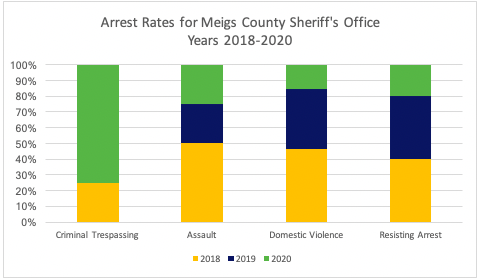
County Jail Blues
The Meigs County Jail has closed for good because of the impact of the COVID-19 pandemic in the rural Ohio area.
The town of Pomeroy is small but picturesque and the main hub for activity in Meigs County. The population of 22,000 people is spread throughout the county that runs along the border of West Virginia. Pomeroy sits along the curving Ohio River, just across the border.
The Meigs County Jail was built in the 1800s and has not been updated for quite some time, but the main reason for the jail’s closure is because of the restrictions of the COVID-19 pandemic. At first, the jail closed for the duration of the pandemic, but eventually the decision for its permanent closure was announced, according to an article published by The Daily Sentinel of Meigs County.
“At the beginning of the pandemic, some counties in the U.S., including in Ohio, either temporarily closed their jails or made efforts to reduce their incarcerated populations,” Kristine Taylor, Ohio University assistant professor in the political science department, says via email. Taylor’s research is in political theory and incarceration and policing.
“Because of this, we will probably see a reduction of facilities without, most likely, a reduction of jail incarceration in SE Ohio. It would take other kinds of policy changes to achieve a reduction of jail incarceration even when a facility closes,” Taylor says.
Small Jail, Big Impact
In a published research article by Rachel Weiss Riley, she and five contributing authors discuss the impact of local jail systems and how they play a significant role in the well-being of its community, despite the lack of research from larger judicial institutions. While the pretrial jail systems in urban areas have steadily declining incarceration rates, rural jail systems are either growing or remaining the same.
This phenomenon is described as “The Urban-Rural Incarceration Divide” which is the disparity of incarceration rates in urban vs. rural areas. A study that started in 1970 showed that incarceration rates of pretrial jails were higher than that of their rural counterparts, but have decreased since that time.
Yet, rural jails have less research than urban jails, ignoring significant trends about the declining safety of these communities. Local jail rates were, on average, approximately 32% lower in suburban areas compared to metropolitan. The Vera Institute of Justice is trying to remedy the lack of exploration done in this area.
By using the Vera Institute of Justice’s research tool, the trend sees a clear increase in incarcerated prisoners, so what will happen to the jail system in this rural community?
According to official arrest records for Meigs County Sheriff’s Office spanning the last three years (2018-2020), there was an average of 24 arrests made each year; in 2018, the total number of arrests was 24; in 2019, the total was 29; in 2020, the total was 19 arrests. But in 2020, the effects of the COVID-19 pandemic likely impacted the number of arrests, which ultimately led to the permanent closure of the jail.
Domestic violence was the leading cause for arrest in the years 2018 and 2019. In 2020, the most common reasons for arrest were trespassing, theft and permitting drug use. The low number of total arrests annually certainly appears low by most standards, but only accounts for the amount of reported crimes that have resulted in arrests – in a community like Meigs County, houses are isolated and usually located on large plots of land surrounded by lush trees.
The Rural Jail
Bill Reader is a professor at Ohio University’s Scripps School of Journalism in Athens. During his years of teaching, he has become familiar with the intricacies of the nearby county and the small towns nestled between the rolling hills of Southeast Ohio.
“This isn’t really a political issue, this is an issue of the realities of rural counties,” Reader says.
According to Reader, the people of Meigs County, like the community in surrounding counties in rural Ohio, are close-knit within their community. He disagreed with the claim that the jail system plays a bigger part in the community, providing insight on the actual context of crimes happening throughout the area.
“Well, you know the jail is such a minor part of the overall law enforcement. I mean, most crimes that the Sheriff’s Department responds to don’t involve somebody going to jail,” Reader says. “Most of them are either resolved on the spot, a citation is issued, and so really, somebody’s not going to go to jail for smoking a joint on the street. Somebody’s gonna go to jail for a fairly substantial grow [marijuana] operation.”
The reality of the jail’s closure was lack of funding and updating the facilities it utilized. Although Meigs County Jail’s closure will impact the community, it will also provide a segue for the sheriff’s department to utilize other resources for keeping the community safe.

